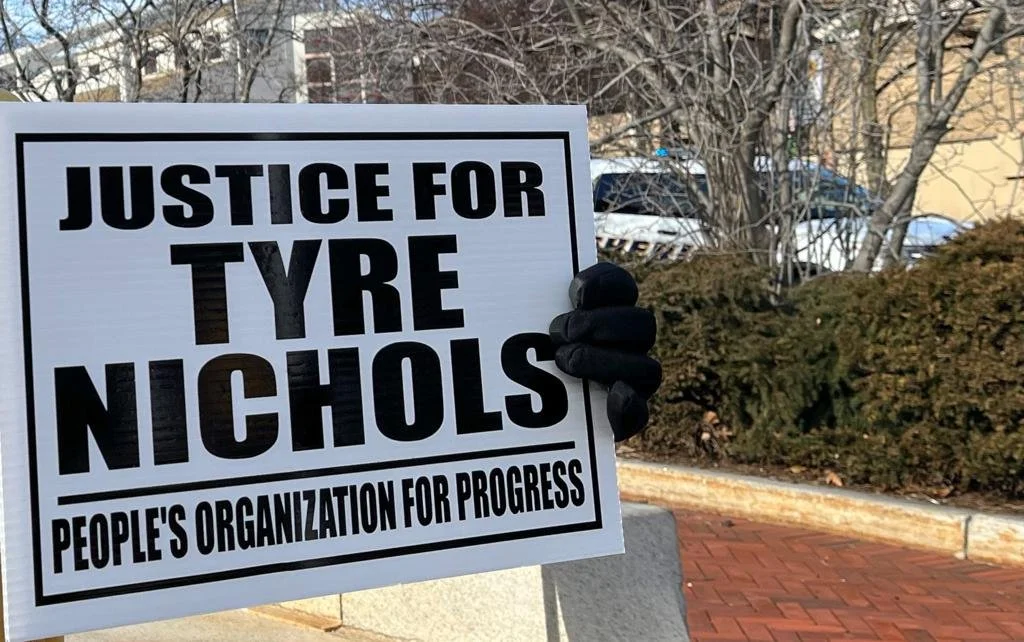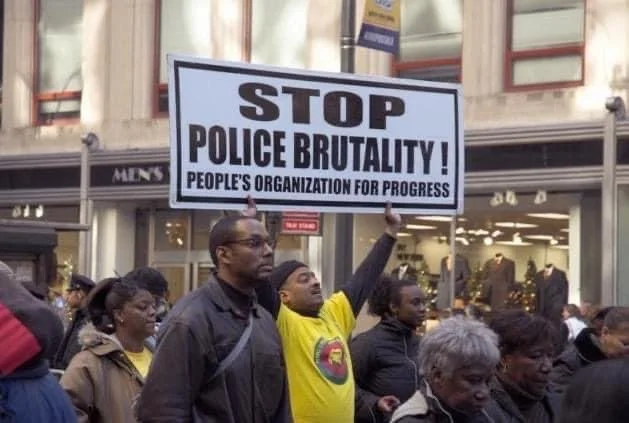Killer Cops and the beating death of Tyre Nichols
A citizen holds a ‘Justice for Tyre Nichols’ placard at a People’s Organization for Progress (P.O.P) march on Jan. 28, Newark, N.J. (Courtesy of Ande Richards)
NEWARK, NJ—The violent beating of 29-year-old Black-American motorist Tyre Nichols at the hands of five Black police officers in Memphis, Tenn., on Jan. 7, 2023, and leading to his death three days later, might be considered a sobering event in police-race relations, at least in the minds of many Americans. However, for scholars such as I who have studied this topic for decades, it comes as no surprise.
Whether the location is in Tennessee, New Jersey, California, or elsewhere, racial profiling is exercised by police officers irrespective of their race, gender, or ethnicity. Yet, until Nichols’ death on Jan. 10, a popular view was that unarmed Black men who were shot and killed by police officers were killed by other-race officers. That is, a prevailing view was that Black police officers are more likely to identify with an unarmed Black suspect by not feeling as threatened, and better relate culturally to the mannerisms, as well as the language being exchanged. In other words, Black police officers did not shoot and kill unarmed Black suspects out of unwarranted fear. From one perspective, a person might argue that this view still holds, in that Tyre Nichols was not shot. Instead, he was beaten to death. However, the result is the same. Another unarmed black man has been killed at the hands of law enforcement, just as in the case of George Floyd in Minneapolis and Eric Garner in New York City.
I remember the outrage expressed after the 1991 brutal beating of Rodney King by members of the Los Angeles Police Department following a traffic stop. Many of us argued that it was racially motivated, that Rodney King was beaten by white police officers who could not relate to him culturally or who were simply prejudiced against Black-Americans. The assumption was that such would not have happened if the police officers had been Black. The killing of Tyre Nichols is a sobering event in the minds of many Black-Americans, and others, because just like George Floyd and Eric Garner, Tyre Nichols was unarmed and presented no threat.
However, what is most sobering to me is not just that his accused killers are Black, but that they are college educated young men who had been entrusted to make crime-ridden neighborhoods in Memphis safer through their work within the Street Crimes Operation and Restore Peace in our Neighborhoods (SCORPION) unit, a unit that has since been disbanded by the Memphis Police Department, but had been previously hailed a success by Mayor Jim Strickland.
One of the accused Killers is Tadarrius Bean, 24, who studied criminal justice at the University of Mississippi and was president of his Omega Psi Phi fraternity chapter. Two of the other accused killers, Emmitt Martin, 30, and Desmond Mills, 32, were also members of the same fraternity but at different universities.
Thus, the killing of Tyre Nichols questions many popular views on police reform.
Representative bureaucracy includes the notion that hiring more Black police officers and promoting Blacks into law enforcement leadership positions will create agencies more sensitive to policing and race, as more equitable policies are adopted. Yet, the Memphis Police Department is 60 percent Black, much higher than the 40 percent some scholars have suggested as necessary to change the culture away from racial profiling.
Body-worn and dashboard cameras have been hailed as a deterrent to excessive use of force. The argument is that police officers will think twice before violating policy and procedure in routine pedestrian and traffic stops. Yet, these police officers were equipped with body-worn cameras.
Criminalizing the failure to intervene when a fellow officer is violating policy or procedure became more popular after the 2020 death of George Floyd by Minneapolis police officer Derek Chauvin. The Memphis Police Department had adopted this policy.
Hiring police officers with college degrees results in more equitable decision-making, including routine traffic stops. Unfortunately, it did not matter in the killing of Tyre Nichols. Interestingly, when college educated white police officers kill unarmed Black suspects, it has been used as an argument for hiring more Black police officers.
A citizen holding a placard during a People’s Organization for Progress (P.O.P) rally. (Photo courtesy of Lawrence Hamm’s Facebook)
In New Jersey, there is a concerted effort to diversify police departments across the state to make them more reflective of the populations they serve, as a recent study found them to be overwhelmingly white and male. In light of the Tyre Nichols killing, a question that must be asked is to what extent will it make a difference?
According to multiple reports, these Black-American police officers even lied on the initial police report, writing that Tyre Nichols “started to fight with the officers and at one point grabbed one of their guns.” However, such statements were not supported by the video footage of the events.
When I was interviewed by Slate.com following the conviction of Derek Chauvin for the killing of George Floyd, I was asked my opinion on the conviction and its impact going forward. As I said then, I think that changing the laws to the point where police officers know they cannot engage in certain types of behavior and go unpunished is the answer. Members of law enforcement must be convicted and given the death penalty for aggravated and unnecessary deadly force, whether those officers be Black or white. In addition, qualified immunity which prevents police officers from being held personally accountable for their actions must be done away with.
These kinds of problems stem from a law enforcement culture that has a propensity to see Black-American men as more criminally inclined, and thus subjected to more motor vehicle and pedestrian stops. Yet, law enforcement agencies do not exist in a vacuum but are a part of greater society, a society whose views on race and criminal activity is reflective of that in law enforcement.
In addition, researchers have found that individuals who believe police officers treated them unfairly or undeservedly are more likely to view the treatment they received, and ultimately the police, as illegitimate. This is because individuals’ perceptions of legitimacy are largely based upon whether they were treated in an honest, unbiased, and ethical manner, and will cooperate with authorities when they believe their treatment was consistent with legal and moral expectations. By contrast, if individuals feel that their treatment was unwarranted or unfairly stigmatizing, they may become defiant towards legal authority because its agents (e.g., the police) demonstrated a lack of concern for their rights and their desire for dignified and respectful treatment. The effects of exposure to police use of force may be greater among Blacks and Hispanics because non-white designated groups are disproportionately represented in areas plagued by violence, concentrated disadvantage, and/or the absence of pro-social opportunities.
Additional Sources
Clarkson, Joshua J., Edward R. Hirt, Lile Jia, and Marla B. Alexander. "When perception is more
than reality: the effects of perceived versus actual resource depletion on self-regulatory
behavior." Journal of Personality and Social Psychology 98, no. 1 (2010): 29.
Clear, Todd R. Imprisoning communities: How mass incarceration makes disadvantaged
neighborhoods worse. Oxford University Press, 2007.
Crouch, Julie L., Rochelle F. Hanson, Benjamin E. Saunders, Dean G. Kilpatrick, and Heidi S.
Resnick. "Income, race/ethnicity, and exposure to violence in youth: Results from the
national survey of adolescents." Journal of Community Psychology 28, no. 6 (2000): 625.
Krivo, Lauren J., and Ruth D. Peterson. "The structural context of homicide: Accounting for
racial differences in process." American Sociological Review (2000): 547.
Paternoster, Raymond, Robert Brame, Ronet Bachman, and Lawrence W. Sherman (1997) "Do fair
procedures matter? The effect of procedural justice on spouse assault." Law and Society
Review: 163.
Sherman, Lawrence W. (1993) "Defiance, deterrence, and irrelevance: A theory of the criminal
sanction." Journal of Research in Crime and Delinquency 30, no. 4: 445.
Sunshine, Jason, and Tom R. Tyler (2003) "The role of procedural justice and legitimacy in shaping
public support for policing." Law and Society Review 37, no. 3: 513.
Tankebe, Justice (2013) "Viewing things differently: The dimensions of public perceptions of police
legitimacy." Criminology 51, no. 1: 103.
Tyler, Tom R., and Cheryl J. Wakslak (2004) "Profiling and Police Legitimacy: Procedural Justice,
Attributions of Motive, and Acceptance of Police Authority." Criminology 42, no. 2:
253.
Tyler, Tom R. (2003) "Procedural justice, legitimacy, and the effective rule of law." Crime and
Justice 30: 283.
Tyler, Tom R., and Yuen Huo (2002) Trust in the law: encouraging public cooperation with the police
and courts through. Russell Sage Foundation.
Tyler, Tom R. (1988) "What is procedural justice-criteria used by citizens to assess the fairness of legal
procedures." Law and Society Review 22: 103.
Tyler, Tom R. (1990) "Why people obey the law: Procedural justice, legitimacy, and compliance."
Princeton University Press.
Western, Bruce (2006) Punishment and inequality in America. Russell Sage Foundation.


